Quick Look
Grade Level: 4 (3-5)
Time Required: 1 hour
Expendable Cost/Group: US $3.00 This activity is for stations where the materials are re-useable each time. The total cost for 4 stations is ~$20.
Group Size: 3
Activity Dependency: None
Subject Areas: Earth and Space, Physical Science, Science and Technology
NGSS Performance Expectations:

| 4-PS3-2 |
| 4-PS4-2 |
Summary
Student groups rotate through four stations to examine light energy behavior: refraction, magnification, prisms and polarization. They see how a beam of light is refracted (bent) through various transparent mediums. While learning how a magnifying glass works, students see how the orientation of an image changes with the distance of the lens from its focal point. They also discover how a prism works by refracting light and making rainbows. And, students investigate the polar nature of light using sunglasses and polarized light film.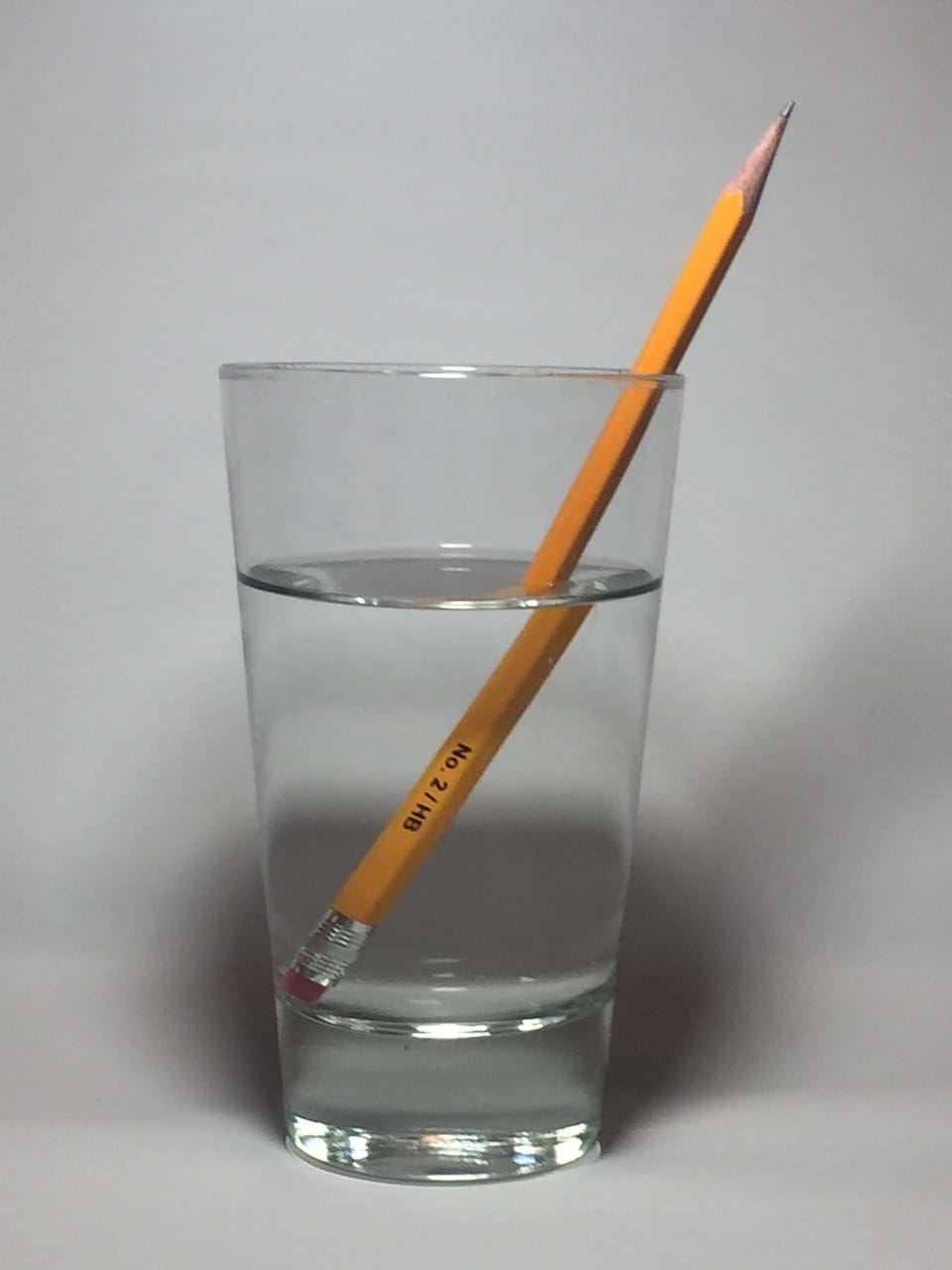
Engineering Connection
Engineers apply their knowledge of the properties of light and light energy to the creation of many useful products and tools. Civil and structural engineers study light properties to determine the optimum type of windows to install in a building. Engineers also use their knowledge of light energy, lenses and prisms as they design eye glasses, binoculars, cameras, medical equipment, satellites, optics and lasers. By understanding polarized light, engineers have created laser applications, electron microscope imaging and medical imaging techniques, in addition to sunglasses and camera filters that reduce the glare from the sun.
Learning Objectives
After this activity, students should be able to:
- Understand the phenomenon of refraction — that when light travels across the border of two transparent media (such as air, glass, Lucite, etc.), the path of light bends.
- Understand that light is made up of waves, and that waves at different wavelengths create different colors.
- Understand that a prism sorts a light beam into its various wavelengths, appearing as a rainbow of colored light.
- Explain that there are also waves that cannot be seen by the human eye that affect our daily lives. For example, we wear sunscreen and sunglasses to protect our skin and eyes from ultraviolet waves.
Educational Standards
Each TeachEngineering lesson or activity is correlated to one or more K-12 science,
technology, engineering or math (STEM) educational standards.
All 100,000+ K-12 STEM standards covered in TeachEngineering are collected, maintained and packaged by the Achievement Standards Network (ASN),
a project of D2L (www.achievementstandards.org).
In the ASN, standards are hierarchically structured: first by source; e.g., by state; within source by type; e.g., science or mathematics;
within type by subtype, then by grade, etc.
Each TeachEngineering lesson or activity is correlated to one or more K-12 science, technology, engineering or math (STEM) educational standards.
All 100,000+ K-12 STEM standards covered in TeachEngineering are collected, maintained and packaged by the Achievement Standards Network (ASN), a project of D2L (www.achievementstandards.org).
In the ASN, standards are hierarchically structured: first by source; e.g., by state; within source by type; e.g., science or mathematics; within type by subtype, then by grade, etc.
NGSS: Next Generation Science Standards - Science
| NGSS Performance Expectation | ||
|---|---|---|
|
4-PS3-2. Make observations to provide evidence that energy can be transferred from place to place by sound, light, heat, and electric currents. (Grade 4) Do you agree with this alignment? |
||
| Click to view other curriculum aligned to this Performance Expectation | ||
| This activity focuses on the following Three Dimensional Learning aspects of NGSS: | ||
| Science & Engineering Practices | Disciplinary Core Ideas | Crosscutting Concepts |
| Make observations to produce data to serve as the basis for evidence for an explanation of a phenomenon or test a design solution. Alignment agreement: | Energy can be moved from place to place by moving objects or through sound, light, or electric currents. Alignment agreement: Energy is present whenever there are moving objects, sound, light, or heat. When objects collide, energy can be transferred from one object to another, thereby changing their motion. In such collisions, some energy is typically also transferred to the surrounding air; as a result, the air gets heated and sound is produced.Alignment agreement: Light also transfers energy from place to place.Alignment agreement: Energy can also be transferred from place to place by electric currents, which can then be used locally to produce motion, sound, heat, or light. The currents may have been produced to begin with by transforming the energy of motion into electrical energy.Alignment agreement: | Energy can be transferred in various ways and between objects. Alignment agreement: |
| NGSS Performance Expectation | ||
|---|---|---|
|
4-PS4-2. Develop a model to describe that light reflecting from objects and entering the eye allows objects to be seen. (Grade 4) Do you agree with this alignment? |
||
| Click to view other curriculum aligned to this Performance Expectation | ||
| This activity focuses on the following Three Dimensional Learning aspects of NGSS: | ||
| Science & Engineering Practices | Disciplinary Core Ideas | Crosscutting Concepts |
| Develop models to describe phenomena. Alignment agreement: | An object can be seen when light reflected from its surface enters the eyes. Alignment agreement: | Cause and effect relationships are routinely identified. Alignment agreement: |
Common Core State Standards - Math
-
Recognize angles as geometric shapes that are formed wherever two rays share a common endpoint, and understand concepts of angle measurement:
(Grade
4)
More Details
Do you agree with this alignment?
International Technology and Engineering Educators Association - Technology
-
Explain how various relationships can exist between technology and engineering and other content areas.
(Grades
3 -
5)
More Details
Do you agree with this alignment?
State Standards
Colorado - Math
-
Describe angles as geometric shapes that are formed wherever two rays share a common endpoint, and explain concepts of angle measurement.
(Grade
4)
More Details
Do you agree with this alignment?
Colorado - Science
-
Energy comes in many forms such as light, heat, sound, magnetic, chemical, and electrical
(Grade
4)
More Details
Do you agree with this alignment?
Materials List
- slinky (optional demonstration; see Introduction/Motivation section)
- Light Energy Worksheet, 1 per student
The materials at each station are re-usable for an unlimited number of teams. The total cost for four stations is ~$20.
Station 1: Bending Light
- 1 clear plastic bowl (deep enough to show refraction)
- 1 plastic ruler or pencil or popsicle stick (or any straight object that can get wet)
- tap water (to fill the bowl)
Station 2: Lens and Light
- magnifying glass (1 or more)
- paper with words or pictures on it
Station 3: Prism Rainbows
- 1-5 prisms (can be assorted sizes) (available in science supply catalogs or websites, or hobby stores)
- 1 light source (such as: overhead projector, slide projector, sunlight through opening in window shades, flashlight)
- Visible Light Spectrum (visual aid)
- Dispersion Angle through a Prism (visual aid)
Station 4: Polarized Light
- two pairs of polarized sunglasses
- piece of plastic polarized film (purchase at a hardware store)
Worksheets and Attachments
Visit [www.teachengineering.org/activities/view/cub_energy2_lesson03_activity1] to print or download.Introduction/Motivation
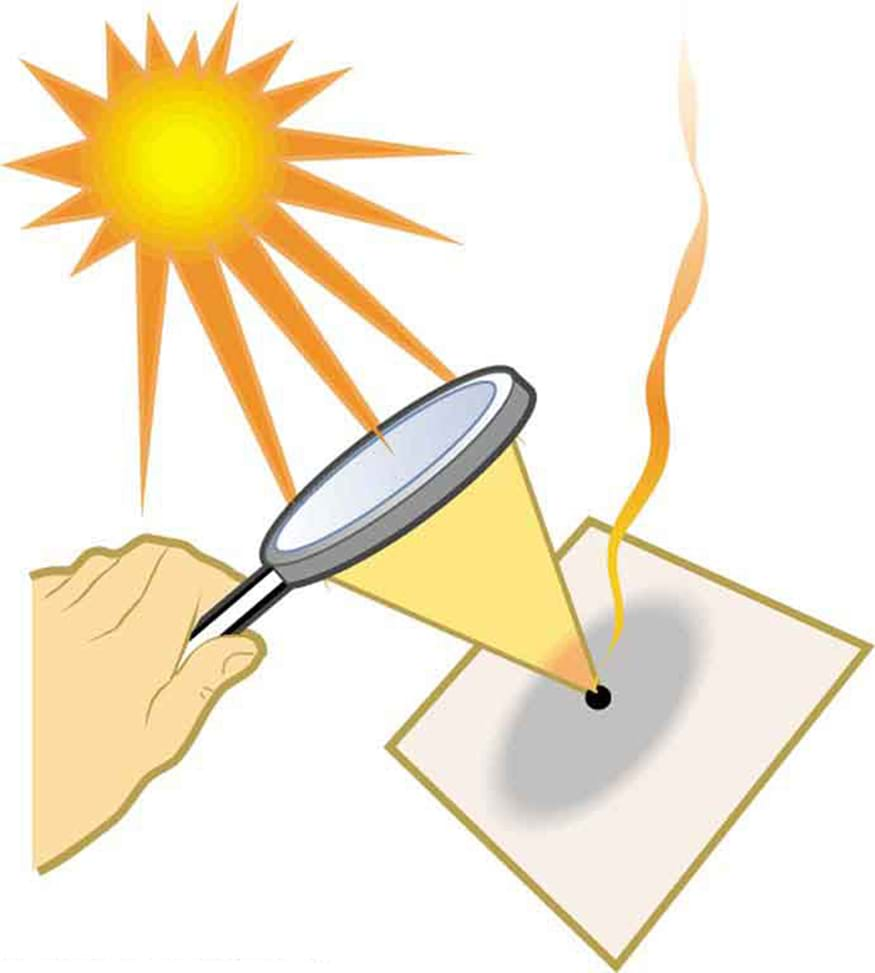
Light is amazing! It is a form of energy that can bend and bounce, and it comes in all different colors. What do you call it when light bounces off something? It is called reflection. And, that is what is happening when we look at our reflection in the mirror — light is bouncing back at us from the mirror. When light bends through something, such as water, it is called refraction. Have you ever been in a swimming pool and seen someone in the water look cut off at the surface of the water? What you are seeing is due to refraction. Have you ever played with a prism? Well, we are going to look at one today to see another form of bending, or refraction, of light. How about a magnifying glass? Well, that is a way light energy waves are refracted to make an image seem larger.
Demonstration idea: If a slinky is available, use it to show how waves vibrate in different wavelengths. Explain how the different "wavelengths" correspond to different colors. Use the slinky to show the class that waves can vibrate in any plane (vertical, horizontal or any angle in between). White light contains all of the wavelengths of the visible light spectrum (see Figure 1) and all of the possible angles shown by the slinky.
Who remembers the colors of the rainbow? Have you ever noticed that the colors of a rainbow are always in exactly the same order? Show students the Visible Light Spectrum visual aid (the same as Figure 1). Inform them that ROY G BIV is a good way (acronym) to remember the order of the colors of the rainbow. In addition to these visible light waves, there are many more waves of light that cannot be seen with the human eye! Show students the Electromagnetic Spectrum visual aid. Ultraviolet (UV) waves are even shorter than violet waves and infrared waves are longer than red waves. We can only see the colors in the middle, the visible light spectrum.

Do you know which of these light energy waves causes sunburn and can hurt our eyes. (Answer: Ultraviolet light waves.) What do we do to protect ourselves from UV rays? (We wear hats, sunglasses and sunscreen.)
How does light energy affect us? Our eyes are sensitive to the brilliance of sunshine. Ultraviolet light penetrates clouds and fog, and is reflected back at us from snow and water. If unprotected from the ultraviolet waves, our eyes can be burned and/or permanently damaged. We can reduce this risk by wearing a high-quality pair of polarized sunglasses designed by engineers to limit the amount of ultraviolet light reaching our eyes.
How do polarized sunglasses work? Well, if we have a piece of paper containing a vertical (up and down) slit, what light do you think would pass through? Only waves in the vertical plane would pass through. The same applies for a horizontal slit and horizontal waves. When light reflects off water, all of the waves are oriented horizontally. This causes the intense glare off the water's surface you may have noticed. Polarized sunglasses work much like a letter going in to a mail box slot. If the letter is not positioned correctly then it cannot go into the mail box.
What do you predict would happen to light trying to pass through two polarized lenses oriented perpendicular to each other? (Answer: Wait for the hands-on activity to find out for yourself!)
Years ago (even in prehistoric times), Inuit people (also called Eskimos) who live in the snowy Arctic carved goggles of wood or bone with a narrow horizontal slit across the front. This allowed them to better see in "white out" snow conditions when light was coming from every direction and all contours were missing. How do you think this worked? How is this similar or dissimilar to the polarized sunglasses? (Answers: This is the same way that polarized sunglasses work. The horizontal slits only allowed part of the light waves, the horizontal ones, through to the Inuit's eyes.)
In addition to designing sunglasses that protect your eyes, engineers apply their knowledge of polarized light in laser applications, electron microscope imaging and medical imaging techniques.
Today, you will work in small teams and rotate through four stations where you will examine light energy behavior in more detail: refraction, magnification, prisms and polarization.
Procedure
Before the Activity
- Gather materials and make copies of the Light Energy Worksheet.
- Divide the class into teams of 2-4 students each, and hand out the worksheets.
- Plan for each team to take 10-15 minutes at each station to complete the activity and answer worksheet questions.
With the Students
Station 1: Bending Light
- Fill the bowl half full with water. Make sure the bowl is deep enough to demonstrate refraction.
- Have students place the ruler (or pencil or popsicle stick) straight up in the water and slowly lower it towards horizontal.
- Have students record their observations and answer the questions on the worksheet.
What's happening? The ruler appears to be bent at the surface between the water and the air. As the ruler approaches horizontal, the bend appears to increase. This is because when light travels across the border of two transparent media (such as air, glass, Lucite, etc.), the path of light bends. This phenomenon is called refraction.
Engineering connection: Lighting engineers are interested in the properties of light, especially natural daylight. Energy engineers study light properties to determine the best type of windows to put in a building. They are concerned with how much visible light can pass through the window and where it will land in the space, as well as how much illumination and energy the light adds to the space. Glass with high visible transmittance allows much light into the space; glass with high solar heat gain coefficients allows much energy to enter the space.
Station 2: Lens and Light
- Have the students examine the pictures and words through the magnifying glass. What happens if they hold the magnifying glass at different distances?
- Have students record their observations and answer the questions on the worksheet.
What's happening? Some students may notice that images flip when you hold the magnifying glass at a certain distance. This is because the image converges at a focal point. When the image diverges beyond this point, its orientation is flipped (see Figure 2).
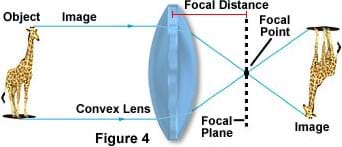
Engineering connection: Engineers use their knowledge of light energy and lenses as they design prescription eye glasses, reading glasses, cameras, contact lenses, eye surgery equipment and techniques, solar energy collection equipment, telescopes, microscopes, satellites, optics and lasers. Using a lens as a light-collecting tool enables engineers and scientists to take photographs in dark rooms and invent other devices to improve our vision of the very tiny, very far away, and locations unsuitable for human life (in hot volcanoes, deep the ocean, in outer space).
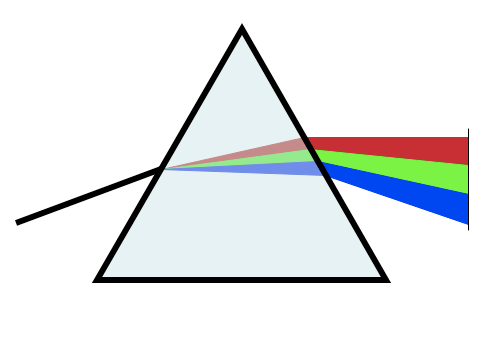
Station 3: Prism Rainbows
- Shine light through the prism to create a rainbow (see Figure 3). The colors are referred to as the visible spectrum.
- White light contains all of the colors in the visible spectrum.
- Have students record their observations when light passes through the prism and answer the questions on the worksheet.
What's happening? The shorter the wavelength, the more that light is bent or refracted by the prism. In a similar situation, light passing through water (or water droplets in the air) can create a rainbow.
Engineering connection: Prisms are used in all sorts of engineered devices. Binoculars use pairs of prisms to lengthen the path of light so that far-away objects appear closer, and also to turn the image, which is reflected off a mirror upside down. Prisms are also used to focus light rays in medical equipment and general lighting applications.
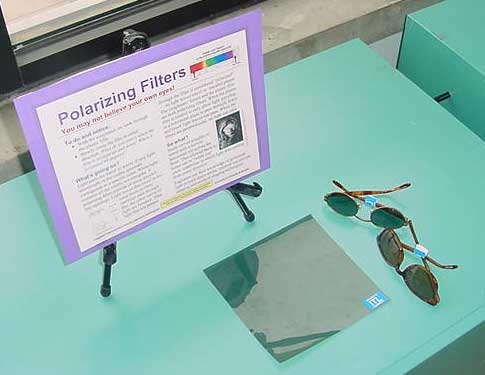
Station 4: Polarized Light
- Have one student put on a pair of polarized sunglasses and hold the plastic polarized film in front of him/her. Then, slowly rotate the film in either direction.
- What do you notice when the film is straight up and down? What do you notice when the film is rotated 90 degrees?
- Have students record their observations and answer the questions on the worksheet.
What's happening? Light particles travel in waves. Every light wavelength in the visible spectrum corresponds to a specific color (see Figure 1). White light contains all the visible wavelengths. A polarizing filter consists of many parallel tiny openings. Light waves traveling in the same plane as the openings pass through the filter, while all other waves of light are blocked (see Figure 5). Light that has passed through the filter is considered "polarized" — its light waves travel in approximately parallel planes. The sunglasses' lenses and the plastic film are both polarizing filters. When the plastic film is rotated to only allow light traveling in a horizontal plane to pass through, fewer and fewer light waves can pass. When the two filters are oriented perpendicular to each other, no light can pass. When the polarized lenses and the polarized film are oriented at 90 degrees, the lenses become opaque.
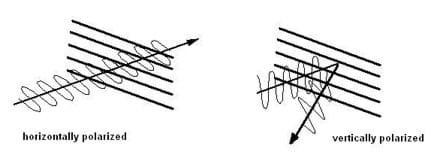
Engineering connection: Engineers apply their knowledge of polarized light in laser applications, electron microscope imaging and medical imaging techniques. They also create sunglasses and camera filters that reduce the glare/reflections from the sun. Polarized light is also used to determine how forces impact machine parts. A copy of the part is made in plastic and viewed under a polarized light as a force is applied. Color bands appear where force is being transferred through the object.
Class Discussion
Conclude the activity by bringing the class together for a discussion and review of their worksheet observations. Review the "What's happening?" and "Engineering connection" information provided in the Procedure section. Conduct the post-activity assessment activities as described in the Assessment section.
Vocabulary/Definitions
convergence: A process of coming together or the state of having come together toward a common point.
electromagnetic spectrum: The entire range of wavelengths or frequencies of electromagnetic radiation extending from gamma rays to the longest radio waves and including visible light. In order of decreasing frequency: cosmic-ray photons, gamma rays, x-rays, ultraviolet radiation, visible light, infrared radiation, microwaves and radio waves.
focus (optics): A point of convergence of light (or other radiation) or a point from which it diverges. Also called the focal point.
indigo: A dark blue to grayish purple blue color. The hue found on the visible spectrum between blue and violet. Named after the blue dye obtained from the indigo plant.
lens: A curved piece of glass that refracts light waves.
light energy: Visible light energy, such as from a light bulb, fireflies, computer screens or stars, is one form of electromagnetic energy. Others forms include infrared, ultraviolet, radio and x-ray. Human eyes are detectors of visible light energy.
magnify: To increase the apparent size of, especially by means of a lens.
polarization: The phenomenon in which waves of light or other radiation are restricted in direction of vibration.
prism: A solid object whose bases or ends have the same size and shape and are parallel to one another, and each of whose sides is a parallelogram. A transparent body of this form, often of glass and usually with triangular ends, used for separating white light passed through it into a spectrum or for reflecting beams of light.
rainbow: An arc of colors, usually identified as red, orange, yellow, green, blue, indigo and violet, that appears in the sky opposite the sun as a result of the refractive dispersion of sunlight in drops of rain or mist. A similar arc or band, as one produced by a prism or by iridescence.
refract: The bending of light as it crosses the between the surface of two transparent materials.
refraction: The ability of light to bend when it crosses a transparent medium.
visible light spectrum: The wavelengths of the electromagnetic spectrum that we can see. Every light wavelength in the visible spectrum corresponds to a specific color White light contains all of the wavelengths of the visible light spectrum. See Figure 1.
wave: (Physics) A disturbance traveling through a medium by which energy is transferred from one particle of the medium to another without causing any permanent displacement of the medium itself.
wavelength: The length between peaks or troughs of a wave. This distance determines the color of a beam of light.
Assessment
Pre-Activity Assessment
Slinky Demo and Discussion: Use a slinky to show the class how waves can vibrate in any plane and in different wavelengths. White light contains all the wavelengths of the visible spectrum and all the possible angles shown by the slinky. Have the students recall the colors of the rainbow and use the slinky to demonstrate that short waves represent violet light and long waves represent red light. Ask the students the following discussion questions:
- What are the colors of the rainbow? (Answer: Explain the ROYGBIV acronym.)
- If a short slinky wave represents a violet color wavelength and a long slinky wave represents the red color wavelength, what do you think the other colors would look like with the slinky? (Make the slinky waves a bit longer for each color from violet to red.)
- What "color" light uses all the colors of the visible light colors, all the colors of the rainbow? (Answer: White light.)
Activity Embedded Assessment
Worksheet: Have the students record their observations on the Light Energy Worksheet. Review their answers to gauge their mastery of the subject.
Post-Activity Assessment
Worksheet Discussion: Discuss with students what is occurring. Have them share their results with the class. For example, have the students discuss why they think the beam of light bent more under water. Also discuss in which type of media refraction occurs. (Answers: Water, air, glass, clear plastic, etc.)
Colors of the Rainbow: Have students make a list of colorful objects, or collect colorful objects from around the classroom. Then have them re-order the objects by wavelength, following the colors of the visible light spectrum or rainbow, with red as the longest wavelength and violet as the shortest.
Make It Real: Engineers use light everywhere! Ask students to provide examples of where and how light energy is used. Generate a class list. Can they think of at least one use that involves a mirror, a lens, a prism and a polarized lens? (Possible examples: To see using flashlights and lamps; reflected light using mirrors and in cameras; visible light in light shows, neon signs and computer screens; for medical technology in x-rays and medical imaging equipment.)
Troubleshooting Tips
These stations could also be conducted as class demonstrations.
If students are not familiar with the visible electromagnetic spectrum, show them the attached Visible Light Spectrum so they can note the order of colors refracted through the prism (ROYGBIV).
Activity Extensions
The Inuit (also called Eskimos) of the Arctic invented sun goggles by cutting slits out of bone, wood or ivory. These native peoples used natural materials to prevent snow blindness and protect their eyes from the glaring bright light reflecting from water, snow and ice. Have students make their own arctic sunglasses. Follow instructions at NASA's Snow Goggles and Limiting Sunlight website, https://blogs.nasa.gov/NES_Teachers_Corner/2011/05/18/post_1305739869505/.
Have the students evaluate the difference between convex and concave lenses. These lenses have different types of focal points, and the images in the lenses look different.
Have the students research the optics of the Hubble Space Telescope. This huge lens orbits about 600 km (375 miles) above the surface of the Earth. It completes one orbit around the Earth every 97 minutes. The Hubble weighs about 11,000 kg (24,000 lbs) on Earth. It is 13.2 meters (43.5 ft) long with a maximum diameter of 4.2 meters (14 ft). As with most telescopes, it is its light collecting power that makes it so effective. It has two mirrors, one is 2 meters (7 ft) wide. Start your research at the NASA (National Aeronautics and Space Administration) website.
Have the students conduct a library or Internet search to learn more about wavelengths. What wavelengths are longer and shorter than the visible spectrum wavelengths? For example, longer than the red wavelengths are invisible infrared (~750 nanometers to 1 millimeter in wavelength), microwaves (1 millimeter to 1 meter in wavelength) and short-wave radio (10-20 meters in wavelength) wavelengths. Provide examples of how engineers have used their understanding of the properties of these invisible wavelengths to create equipment and instruments useful in our everyday lives.
Activity Scaling
- For more advanced students, add a math component by discussing the angle of refraction. Have them calculate and measure the angle of refraction using a protractor. You can also have students identify the dispersion angle of light in the prism and also the wavelengths identified with each of the colors. Have them calculate the range of wavelengths representing the visible spectrum.
- For upper grades, ask the department of geology of a nearby university to loan you or show your students how a petrographic microscope and some thin sections of minerals react to polarized light.
Subscribe
Get the inside scoop on all things TeachEngineering such as new site features, curriculum updates, video releases, and more by signing up for our newsletter!More Curriculum Like This

Students learn about the science and math that explain light behavior, which engineers have exploited to create sunglasses. They examine tinted and polarized lenses, learn about light polarization, transmission, reflection, intensity, attenuation, and how different mediums reduce the intensities of ...

In this introduction to light energy, students learn about reflection and refraction as they learn that light travels in wave form. Through hands-on activities, they see how prisms, magnifying glasses and polarized lenses work.

During this lesson, the electromagnetic spectrum is explained and students learn that visible light makes up only a portion of this wide spectrum. Students also learn that engineers use electromagnetic waves for many different applications.

Students learn about the basic properties of light and how light interacts with objects. They are introduced to the additive and subtractive color systems, and the phenomena of refraction. Students further explore the differences between the additive and subtractive color systems via predictions, ob...
References
The Electromagnetic Spectrum. IMAGERS (Interactive Multimedia Adventures for Grade School Education Using Remote Sensing), GSFC Laboratory for Terrestrial Physics, National Aeronautics and Space Administration (NASA).
Copyright
© 2005 by Regents of the University of ColoradoContributors
Sharon D. Perez-Suarez; Jeff Lyng; Malinda Schaefer Zarske; Denise CarlsonSupporting Program
Integrated Teaching and Learning Program, College of Engineering, University of Colorado BoulderAcknowledgements
The contents of this digital library curriculum were developed under a grant from the Fund for the Improvement of Postsecondary Education (FIPSE), U.S. Department of Education and National Science Foundation GK-12 grant no. 0338326. However, these contents do not necessarily represent the policies of the Department of Education or National Science Foundation, and you should not assume endorsement by the federal government.
Last modified: October 28, 2020







User Comments & Tips